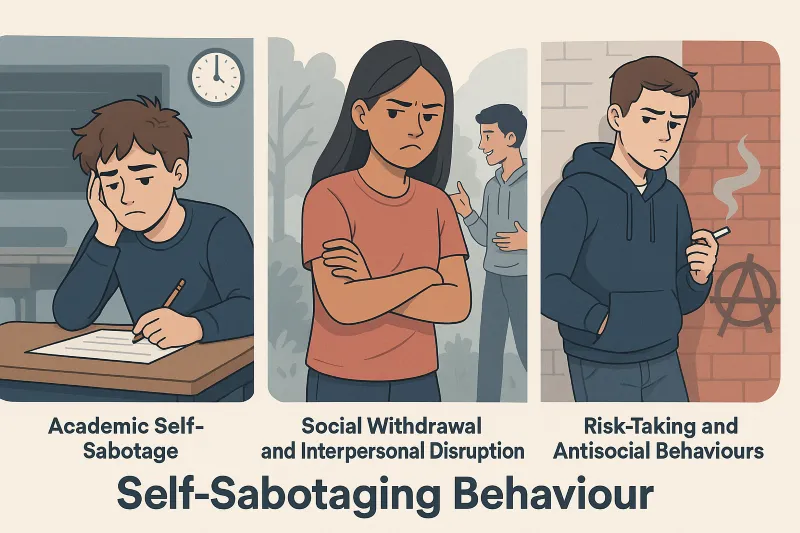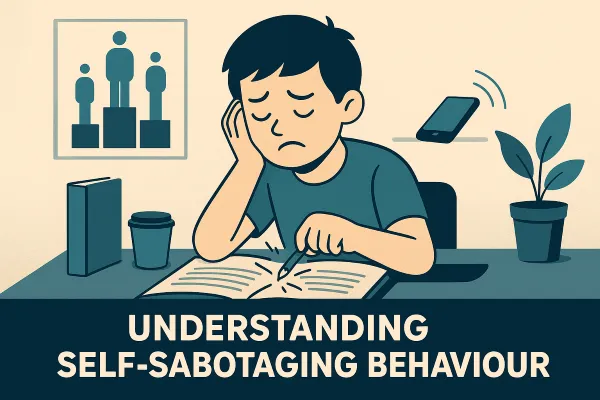What Is Self-Sabotaging Behaviour in Children and Adolescents?
Common Patterns and Triggers of Self-Sabotage in Youth
Self-sabotaging behaviours in children and adolescents involve complex patterns in which young people, often unknowingly, act in ways that undermine their own success, emotional well-being, or developmental growth. These behaviours, such as avoidance, procrastination, or self-defeating choices, can significantly disrupt academic performance, social integration, and emotional regulation (Main and Whatman, 2023).
The journey from childhood to adolescence is marked by profound physical, social, and psychological changes (Bhatt and Pujar, 2019). Within this developmental context, self-sabotage can take root and escalate, sometimes with long-term consequences for mental health and societal participation (McGorry and Mei, 2018).
Understanding these behaviours requires examining both internal psychological processes and the external environments in which children grow and develop (Kirman, 1970). This article explores how self-sabotage emerges from the interaction of cognitive biases, emotional dysregulation, and environmental stressors — factors which may offer momentary relief or control, but at the cost of long-term growth.
As concerns grow about youth disengagement and negative outcomes in schools and social settings (Main and Whatman, 2023; Bland, Carrington and Brady, 2009), unpacking these dynamics is essential. By exploring the underlying mechanisms of self-sabotage, this article aims to support more targeted interventions for children and the adults working alongside them.
Psychological Theories Behind Self-Sabotaging Behaviour in Children
In developmental contexts, self-sabotage refers to behaviours, including both actions and inactions, that interfere with a young person's progress towards their stated or internalised goals (Broughton and Riegel, 1977). Unlike deliberate self-harm (Hawton et al., 2016) or overt defiance, self-sabotage often unfolds in subtle and indirect ways. These behaviours are shaped by a mix of internal vulnerabilities and external pressures.
The form that self-sabotage takes can vary widely depending on a child’s age, stage of cognitive development, and the demands of their environment. In younger children, it may show up as quiet withdrawal, a reluctance to try, or passive avoidance. During adolescence, these behaviours can become more persistent and ingrained, often presenting as disengagement, low self-worth, or a fear of success (Main and Whatman, 2023).
To fully understand these patterns, it is important to explore the underlying psychological theories that explain how self-concept develops and how behaviour is shaped in response to emotional, social, and environmental experiences (Broughton and Riegel, 1977).
How Thoughts, Emotions, and Actions Drive Self-Sabotage in Young People

Self-sabotage can be understood through cognitive, emotional, and behavioural dimensions.
- Cognitively, it may involve negative self-talk, irrational beliefs about personal capability, or a distorted view of success and failure.
- Emotionally, it is often linked to anxiety, fear of failure or success, and low self-worth (Toback, Graham-Bermann and Patel, 2016).
- Behaviourally, it can present as procrastination, avoidance, or disruptive actions that interfere with progress (Main and Whatman, 2023).
These dimensions do not operate in isolation. Cognitive distortions can intensify emotional distress, which in turn can lead to maladaptive behaviours. Recognising these interconnections early is vital for effective support and intervention (Pandey et al., 2018).
How Self-Sabotage Differs from Self-Harm, Defiance, and Disengagement
It is important to distinguish self-sabotage from related constructs such as intentional self-harm or general disengagement. While disengagement can be an early signal of self-sabotaging behaviour, it does not always stem from the same motivations or internal processes (Main and Whatman, 2023; Bland, Carrington and Brady, 2009).
Self-harm, which involves deliberate physical injury, is a distinct clinical concern. However, it may co-occur with self-sabotaging tendencies, especially when young people experience intense emotional distress (Hawton et al., 2016; Hawton et al., 2015; Howson and Huline-Dickens, 2016).
Self-sabotage is usually less visible than self-harm and often less consciously destructive than overt defiance. Its focus is not on physical harm, but rather on undermining personal growth or success. The key difference lies in the underlying motivation. Self-sabotage often emerges as a protective strategy, aimed at avoiding psychological threats such as the pressure to succeed or the fear of failure.
Understanding this distinction is crucial for developing targeted interventions that respond to the young person's needs without misinterpreting the behaviour.
What Causes Self-Sabotage in Children and Adolescents?
The origins of self-sabotaging behaviours in children and adolescents often lie in complex internal processes. These psychological mechanisms, many of which operate outside of conscious awareness, influence behaviour in ways that may seem irrational or counterproductive. Understanding these internal drivers is essential for designing effective, sensitive interventions.
Anxiety, Fear of Failure, and Perfectionism
Anxiety, particularly social or performance-related anxiety, is a significant factor contributing to self-sabotage. When young people feel intense pressure or fear of disappointing others, they may subconsciously sabotage their own efforts to avoid the risk of humiliation or perceived failure (McKeague et al., 2017). This can present as avoidance, refusal to try, or procrastination, often leading to the very failure they feared.
Perfectionism, although sometimes viewed as a motivator for success, can also be paralysing. When the standard of success feels impossibly high, young people may avoid tasks altogether to protect themselves from falling short. This avoidance becomes a form of self-protection, even as it undermines achievement.
Attachment Styles and Relational Dynamics
Early attachment relationships play a foundational role in shaping how children understand themselves and others. Insecure attachment styles, including anxious and avoidant patterns, can contribute to self-sabotage in relational settings. A child with an anxious attachment style may seek constant reassurance by testing others, sometimes provoking conflict or rejection to confirm their fears of abandonment.
Conversely, children with avoidant attachment tendencies may withdraw emotionally or socially to avoid potential rejection, limiting opportunities for connection. Over time, these patterns can erode peer relationships and reduce a young person's sense of belonging and trust (Torres Santos, 2018).
Identity Formation and Self-Esteem Trajectories
Adolescence is a critical time for shaping identity and self-esteem (Torres Santos, 2018). When self-esteem is fragile, young people may internalise negative beliefs about their worth or abilities. These beliefs can become self-fulfilling, leading to disengagement or deliberate underperformance to avoid exposing perceived weaknesses (Toback, Graham-Bermann and Patel, 2016).
In some cases, young people begin to identify with their own perceived inadequacies. Maintaining this identity, even when it leads to negative outcomes, can offer a sense of control or consistency. This dynamic can make self-sabotage difficult to shift without targeted, identity-affirming support.
How Family, School, and Culture Shape Self-Sabotaging Behaviour
In addition to individual psychological factors, the immediate and broader environments in which a young person grows up play a significant role in the development and persistence of self-sabotaging behaviours. These external influences can either buffer against vulnerability or amplify it, depending on the consistency, expectations, and relational dynamics present.
Parental Expectations and Modelling
The family environment, especially parental expectations and modelling, has a profound impact. Unrealistic or excessive expectations, whether related to academic performance or behavioural conformity, can create internal pressure. In response, children may engage in self-sabotaging behaviours as a form of coping or silent resistance.
Alternatively, a lack of structure or inconsistent boundaries may lead to underdeveloped self-regulation skills and chronic underperformance (Roberts et al., 2006).
Parents who model maladaptive coping strategies such as avoidance, blame-shifting, or perfectionism may inadvertently reinforce self-sabotaging behaviours in their children. Importantly, studies show that parental engagement is often a key determinant in the success of intervention strategies (Fenner et al., 2016; Lindsay et al., 2013).
Peer Relationships and Social Belonging

The desire for acceptance within peer groups is especially powerful during adolescence. Self-sabotage may emerge from a fear of social rejection, particularly when success sets a young person apart. In some contexts, young people may downplay their abilities or avoid achievement to conform to group norms that reward non-conformity or disengagement.
Others may disrupt friendships or withdraw emotionally to maintain a sense of control or avoid deeper vulnerability (Torres Santos, 2018).
On the other hand, young people experiencing social exclusion or bullying may adopt self-sabotaging behaviours as a way of expressing internal distress or seeking connection, even if that connection is through negative attention (Main and Whatman, 2023; Bland, Carrington and Brady, 2009).
Cultural Narratives and Systemic Pressures
Wider cultural and systemic influences also shape young people’s behaviour. Education systems that place a strong emphasis on testing and performance can unintentionally foster conditions for self-sabotage, particularly in students who feel overwhelmed or unsupported (Bland, Carrington and Brady, 2009).
Socioeconomic inequality, cultural expectations around gender roles, and dominant narratives about success and failure can all contribute to identity conflicts that drive maladaptive coping.
Social media adds another layer of complexity. The pressure to maintain a curated digital identity may cause young people to engage in self-sabotaging behaviours when their real-life growth, interests, or vulnerabilities clash with their online persona (Main and Whatman, 2023).
Integrating the Systemic Picture
Together, these environmental influences do not operate in isolation. Family dynamics, school culture, peer relationships, and wider socio-cultural messages all interact to shape how young people view themselves and navigate challenge. Understanding these intersecting factors is vital for designing interventions that are not only psychologically informed but also socially and culturally responsive.
Real-Life Examples of Self-Sabotaging Behaviour in Youth
The varied expressions of self-sabotaging behaviours in children and adolescents can be better understood through common patterns observed in school and social settings. These illustrative vignettes highlight how internal drivers and environmental influences interact, producing behaviours that may appear confusing or contradictory to adults.
Academic Self-Sabotage: Why Some Capable Students Underperform
In educational contexts, self-sabotage often appears as chronic avoidance or deliberate underperformance, even among students with strong potential. This might include consistently missing deadlines, refusing to engage in class, or achieving below known ability levels.
For example, a student experiencing intense anxiety about expectations may repeatedly "forget" homework, appear distracted during lessons, or underachieve in assessments. These behaviours, while counterintuitive, can offer temporary relief from the pressure to succeed or protect a fragile self-concept by externalising the cause of failure (Main and Whatman, 2023).
Such patterns typically unfold over time and may be misinterpreted as laziness or apathy without careful observation of the underlying distress.
Social Self-Sabotage: Avoidance and Relationship Breakdown
In social settings, self-sabotaging behaviours can include withdrawing from friendships or initiating conflict. A young person who fears rejection may isolate themselves or provoke arguments to push others away before they have a chance to leave voluntarily.
This form of self-protection, though painful, serves to maintain a sense of control and predictability. Over time, such behaviours may become entrenched, especially during adolescence, when peer relationships are central to emotional development and identity formation.
Risky Behaviour as a Form of Self-Sabotage in Adolescents
At the more extreme end of the spectrum, self-sabotage may present as risk-taking or antisocial behaviours, such as substance use, defiance, or minor delinquency. While these behaviours can be harmful or even dangerous, they often reflect deeper emotional struggles.
In some cases, they may be attempts to assert control in an otherwise unstable environment, or expressions of pain that the young person is unable to articulate in healthier ways (Kerfoot, McNiven and Gill, 1997; Lestari, 2018). These acts can briefly offer a sense of agency or connection, even if the consequences are negative or long-lasting.
Interpreting the Patterns
These examples show that self-sabotage does not follow a single path. Whether it appears as quiet avoidance or loud disruption, the underlying need is often the same — a need for safety, understanding, and emotional regulation. Recognising these patterns across contexts is essential for early identification, trauma-informed responses, and the development of effective, compassionate interventions.
Effects of Self-Sabotage on Academic, Social, and Emotional Development
Consequences for Academic, Social, and Emotional Development
Self-sabotaging behaviours have wide-ranging effects across a young person's development.
- Academically, ongoing underachievement and disengagement can contribute to a widening skills gap, reduced attainment, and negative attitudes toward learning (Main and Whatman, 2023; Bland, Carrington and Brady, 2009).
- Socially, these behaviours often lead to isolation, difficulties in peer relationships, and a reduced capacity to form healthy, trusting connections.
- Emotionally, self-sabotage reinforces patterns of low self-worth, heightened anxiety, and a reduced sense of personal agency, limiting the development of effective coping strategies (Toback, Graham-Bermann and Patel, 2016).
Over time, these consequences can compound, creating a downward cycle that becomes increasingly difficult to interrupt without targeted, sustained intervention.
Why Self-Sabotage in Youth Is Often Missed or Misunderstood
Several factors hinder the timely identification and support of self-sabotaging behaviour in youth.
Firstly, because self-sabotage is often indirect and covert, it may be misinterpreted as laziness, defiance, or lack of motivation, rather than as an expression of distress. Such misinterpretations can lead to punitive responses that further entrench the behaviour.
Secondly, young people may not recognise their actions as self-sabotaging. To them, avoiding risk, withdrawing from challenges, or failing on purpose may feel like rational responses to perceived threats or overwhelming expectations.
Finally, a lack of awareness among adults — whether educators, caregivers, or clinicians — about the psychological mechanisms behind these behaviours can delay or derail effective support. The success of intervention often depends on developmental appropriateness and emotional attunement (Daniel and Goldston, 2009).
School and Mental Health System Gaps in Supporting Self-Sabotaging Youth
Schools and clinical services both face structural limitations when addressing self-sabotaging behaviours.
Educational responses often prioritise academic remediation or behavioural compliance, which may overlook the emotional and relational needs that contribute to disengagement (Main and Whatman, 2023). Although social and emotional learning (SEL) programmes are increasingly recognised as beneficial, they are not always adapted or targeted toward students showing early signs of self-sabotage.
In clinical settings, services may be limited, particularly for young people whose distress is not outwardly disruptive. Long waiting times, eligibility thresholds, and the stigma of mental health support can further complicate access. These gaps highlight the need for integrated, cross-disciplinary approaches that bring together academic, emotional, and social support systems (Tolan, 2016).
How Age, Gender, and Background Affect Youth Self-Sabotage
Self-sabotaging behaviours do not present uniformly across age groups or demographic backgrounds.
In younger children, they may appear as school refusal, task avoidance, or oppositional behaviour (Main and Whatman, 2023). In adolescents, patterns may escalate into chronic underachievement, emotional withdrawal, or risk-taking behaviours (Kerfoot, McNiven and Gill, 1997).
Demographic factors also play a significant role. Socioeconomic disadvantage, cultural expectations, and gender norms can all influence both the expression of self-sabotage and the availability of support. For instance, young people from marginalised backgrounds may experience additional systemic barriers that amplify the effects of disengagement and limit access to early intervention (Bland, Carrington and Brady, 2009).
Understanding these variations is essential to ensuring that interventions are culturally responsive, developmentally appropriate, and equitably accessible.
Supporting Self-Sabotaging Youth: What Adults Need to Know
Synthesis of Findings and Theoretical Implications
This exploration of self-sabotaging behaviours in children and adolescents reveals a complex interaction between internal psychological processes and external environmental influences. Although these behaviours may appear irrational or self-defeating, they often function as maladaptive coping strategies rooted in anxiety, fear of failure, perfectionism, or fragile identity development.
Family dynamics, peer relationships, and wider socio-cultural expectations play a pivotal role in shaping the way self-sabotage is expressed and maintained. The theoretical implication is clear: self-sabotage should not be viewed simply as a motivational deficit or behavioural defiance. Instead, it should be understood as a protective mechanism — albeit an ineffective one — that attempts to manage overwhelming emotions or unmet needs.
To respond effectively, interventions must go beyond surface-level behavioural correction. They should address the root causes through developmentally sensitive, emotionally attuned, and relationally informed approaches that support resilience, agency, and adaptive coping.
How Parents, Teachers, and Professionals Can Help Children Who Self-Sabotage

Adults working with children and adolescents can play a vital role in reducing the risk and impact of self-sabotaging behaviours. The following strategies can guide early identification, prevention, and responsive support:
- Foster Emotional Literacy
Help young people recognise and name their emotions, especially feelings related to anxiety, fear, and shame. Create safe, non-judgemental environments where emotional expression is encouraged and validated. - Promote a Growth Mindset
Reinforce the idea that ability is not fixed and that effort, mistakes, and persistence lead to growth. Help children view setbacks as learning opportunities rather than personal failures. - Set Realistic and Supportive Expectations
Ensure expectations are high enough to encourage challenge but remain achievable. Celebrate progress and personal improvement, rather than focusing solely on comparative academic or social success. - Strengthen Self-Regulation and Coping Skills
Implement social and emotional learning (SEL) programmes that build young people's capacity for emotional regulation, problem-solving, and healthy relationships (Main and Whatman, 2023). - Cultivate Secure, Trusting Relationships
Relationships with consistent, supportive adults are central to a child’s resilience. For families experiencing strain, consider family-based support or therapeutic intervention (Fenner et al., 2016). - Seek Professional Support When Needed
When self-sabotaging patterns become persistent, pervasive, or harmful, timely intervention from educational psychologists, counsellors, or mental health professionals is crucial. Early support can disrupt negative developmental trajectories and promote long-term wellbeing (Berkowitz, Stover and Marans, 2010).
By recognising self-sabotage as a signal of deeper distress rather than defiance, adults can respond with compassion, insight, and strategies that empower young people to succeed on their own terms.


